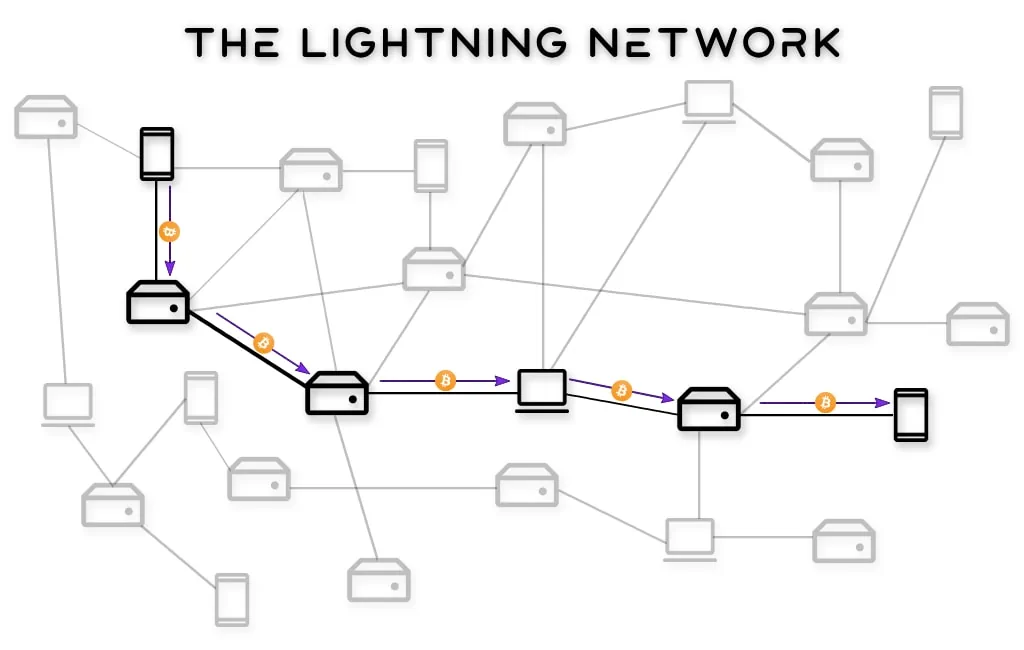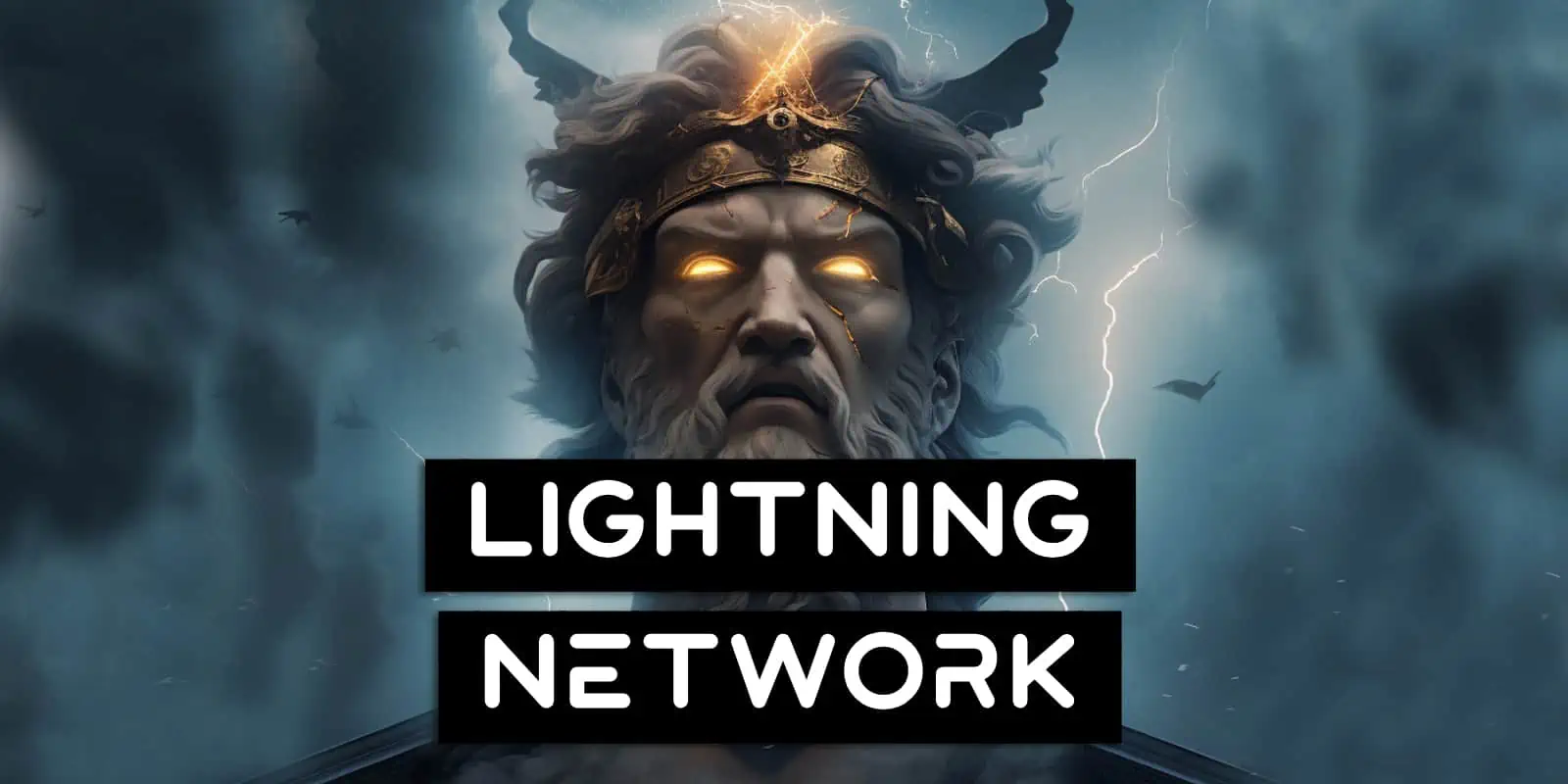Long ago it became clear that Bitcoin was facing a big problem. How would it scale to billions of users without having huge fees and long confirmation times? To address these problems two engineers created the Lightning Network which has ushered in a new era of transacting with Bitcoin and may one day obliterate not just banks, but payment processors like Visa.
Contents
What Is The Lightning Network?
The Bitcoin Lightning Network is a decentralized network of nodes that sits on top of the base, Bitcoin Network. This Layer 2 network as it’s often called allows for instant, near zero fee, high volume micropayments all without having to involve trusted third parties like banks or payments processor like Visa or Master Card.
How Does The Lightning Network Work?
The Lightning Network is made up of thousands of privately owned nodes and wallets. Each node opens one or more Lightning Channels with other nodes allowing them to send and receive payments to each other near instantly.

These channels are linked back to the Bitcoin Network with real Bitcoin Transactions which lock up a certain amount of bitcoin funds in a two-party, Multisignature Bitcoin Address. While the details behind these channels can get quite technical, it enables the network to route payments from one node to another just like your data gets routed through the Internet.
To an average user, they can buy a coffee and pay for it with their Lightning Wallet all without using any banks, payment processors or other trusted third parties. The payment is routed from their custodial Lightning Wallet, through various Lightning Nodes and onto the coffee shop which receives their bitcoins instantly.
Benefits And Risks Of The Lightning Network
Lightning has a number of great features that has allowed Bitcoin to realize its original goal of being a peer-to-peer electronic cash. Benefits include:
- Instant Payments: Bitcoin transactions can take from 2 minutes to an hour to be fully confirmed, Lightning Transactions happen near instantly as no block confirmations are required. This allows Bitcoin to be used for day to day transactions like buying lunch
- Micropayments: Lightning allows you to send funds as small as 0.00000001 bitcoin or 1 Satoshi without any custodial risk. This allows for novel types of business models like charging per minute for a podcast or paying for single use API access
- Scalability: Lightning allows essentially infinite scaling as the network capacity increases as more nodes are added, this means Bitcoin can scale up to billions of users
- Lower Fees: A common fee charged by major Lightning Nodes is around 0.05%. This means to send $100 costs just $0.05, far less than what Bitcoin, Visa or MasterCard charges
- Privacy: Since all payments sent and received between Lightning Nodes occur off the Bitcoin Blockchain, they aren’t recorded or viewable to the general public making it more private
While that’s a lot of great benefits, the Lightning Network isn’t perfect. There are also risks and challenges ahead that still need to be solved such as:
- No Hardware Wallet Support: As Lightning Nodes are always online, this turns them into Hot Wallets with no possibility for the funds to be stored in a Hardware Wallet. This increases the risk of hacking and having the funds stolen
- Operational Risks: Running a Lightning Node has gotten a lot easier over the last few years, but there are still a number of things that can go wrong resulting in the loss of funds
- Centralization Risks: While anyone can run their own Lightning Node, it’s possible large and highly connected nodes may eventually emerge which could centralize the network. This could then lead to censorship or the ability for governments or big businesses to take over
- Relatively New: The Lightning code was released in 2016 meaning it’s still a relatively new protocol that could have unknown bugs or security holes in it. While it gets bigger and better everyday, most channels are still limited to around 5 million Satoshi or about $2,500 USD
New to Athena Alpha? Start today!
How To Use The Bitcoin Lightning Network
For most people, the easiest way to use the Lightning Network is to simply download a Lightning Network Wallet app on your phone. There are a number of excellent and widely supported wallets out there, a few we recommend are:
- Phoenix Wallet – Can connect to your own Node
- Wallet Of Satoshi
- Muun Wallet
- BlueWallet – Can connect to your own Node
All of these wallets have both Android and iOS apps with simple interfaces that allow you to get up and running almost instantly.
Security Note: Make sure to double check the apps name, company and other details before installing it. There are a number of scam wallets on both app stores, some with hundreds of thousands of installs, that will steal all your funds!
A final way you can use the Lightning Network is by using a Lightning Exchange. These are exchanges that let you buy and sell bitcoins via the Lightning Network. One of our top rated exchanges is RoboSats that does just this and as a result, has extremely low fees and near instant trading.
How To Invest In The Lightning Network
While you can’t buy shares of the Lightning Network, there are two main ways to invest in it:
- Buy Bitcoin: As the native token of the Lightning Network is Bitcoin, you can get exposure to it by simply buying and holding it over the long term
- Run A Node: If you want to get a little more hands on, you can use an old or new computer to run your own Lightning Node. This allows you to become part of the global Lightning Network and route other peoples payments. You get to set your own fees and receive a percentage of the transaction just like Visa or MasterCard does
While owning and running your own Lightning Node isn’t exactly passive income, it’s a great way to learn a new skill, get first hand experience with the Bitcoin and Lightning Network and has a very low cost to entry. We go over all the details in our previous piece: Bitcoin Lightning Node Profitability: ROI & What To Know Before Investing.
Learn More: Why Run A Bitcoin Node?
FAQ
Who Owns The Lightning Network?
While Lightning Labs developed and maintains the Lightning Network code, the network itself is deployed on tens of thousands of different nodes all around the world. So just like the Internet, nobody and everybody owns the Lightning Network.
Who Created The Lightning Network?
In Feb 2015, Joseph Poon and Tadge Dryja started working on the Lightning Network and in Jan 2016 released the Lightning Network Whitepaper. Shortly after Lightning Labs released a beta version for testing and it has only grown since then.
What Is The Downside Of The Lightning Network?
The Lightning Network has a number of upsides, but also currently has a few key downsides including:
– No Hardware Wallet support for funds in Lightning Channels
– Loss of funds due to miss configuration or not backing up channels properly
– Centralization risks if large scale, highly connected nodes get too big
Is There A Lightning Network Coin?
The Lightning Network has no coin. Instead it uses the coin native to the Bitcoin Network which is bitcoin (BTC). This is because it is a Layer 2 network that sits on top of the Bitcoin Layer 1 base network.



